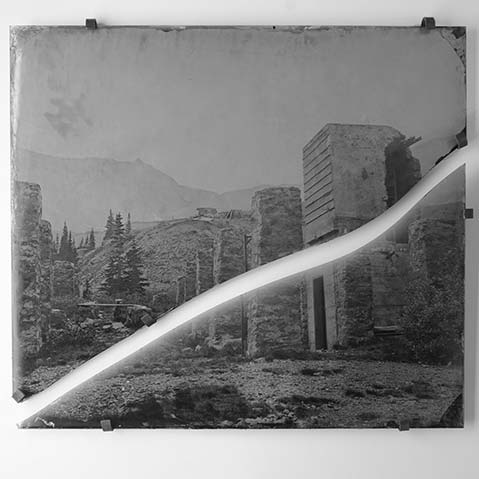Lindsey Ross and R. Nelson Parrish
‘Slow Hands’ Exhibit Explores Tangibility of Time

This excellent new two-person show invites both sensual engagement and rigorous contemplation. Works such as R. Nelson Parrish’s dangling sculpture “The Mile Long Club” (2016) and Lindsey Ross’s ambrotype photo “Smuggler-Union Power Plant” (2016) soak up all the attention a viewer pays them, and on multiple levels.
At the show’s opening, one enthusiastic gallery-goer could not keep her hands off the smooth and shiny surface of “The Mile Long Club,” a level of engagement that the artist, somewhat to my surprise, encouraged. According to Parrish, the bright colors, striated and multilayered organic patterning, and glossy skins he creates are the product of “magic” techniques involving significant quantities of bio-resin and — this part I’m assuming — elbow grease. It’s the inquisitive visitor, rather than the grabby one, who will cop the most interesting feel for Parrish’s work, as there’s a lot going on beneath and beyond their dazzling surfaces. While they share certain tactile qualities of finish with hand-shaped surfboards and custom cars, these enigmatic objects actually began as “flitches,” a logging term for the discarded first cut that’s made when squaring up timber up at the mill. Even when he’s working with a regular geometric shape, such as the rectangular slab that’s the basis for the stunning major work “East, Looking South” (2016), Parrish reaches back, in this case to his childhood in Alaska, by referring to the piece as a “totem.” At the core of this artist’s work there’s a constant and complex interplay between contemporary visual effects and archaic forms.
Ross makes images using a wet plate collodion technology that’s so antique Wikipedia describes it in the past tense, as in “the wet plate process had a major disadvantage.” She’s not alone — other contemporary artists such as Sally Mann and Kurt Grüng use it, as well — but she’s unquestionably intrepid, as the large-format camera alone weighs 200 pounds. And that major disadvantage Wikipedia mentioned? “The entire process, from coating to developing, had to be done before the plate dried.” This means dipping large glass plates in a silver nitrate solution within 10 minutes of exposure, and requires traveling with a portable darkroom. The images Ross is showing in Slow Hands are achingly beautiful 20″ x 24″ portraits of abandoned mining sites in Colorado and California, all of them remote and at high altitude, somewhere between 7,000 and 11,500 feet.
While you imagine the challenge of hauling a 200-pound camera and a portable darkroom up North America’s most rugged mountains, let me share a story Ross told me about what it can be like getting back down. Alone, on her way home from a mine site shoot in Cerro Gordo, California, and at 7,500 feet, the brakes on Ross’s truck failed, and she found herself slaloming around switchbacks until coming to rest in a crash that totaled the vehicle. She was unhurt, and, miraculously, all but one of the glass collodion plates survived intact. The broken one, which split clean in half, is in the show. “Made at Tomboy 11,500, Broken in Cerro Gordo 7,500” (2016) is an apt emblem of what’s at stake whenever Ross ventures into the wilderness for her art, and although there’s much more to this young woman’s sophisticated approach to her subject matter and method than the simple physical daring involved, without this dramatic element of risk and commitment, its meaning would be incomplete.
Anyone interested in Santa Barbara’s potential to become a center for the art of the 21st century won’t want to miss Slow Hands, which is on display at SBCAST (513 Garden St.) until October 2.



